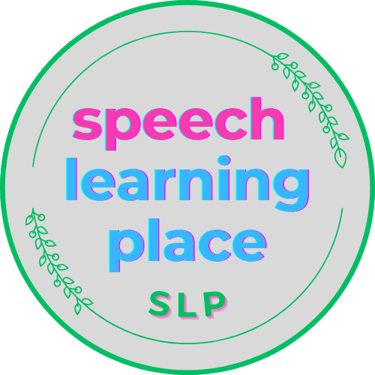Welcome to Speech Learning Place
How I Use AI as an SLP to Save Time and Improve Therapy
As an SLP I use AI to save me time, help me generate ideas and therefore improve therapy!
SaraBeth Cuthbert
2/22/20252 min read


1. Writing and Refining Goals
AI helps me reword goals to ensure they are clear, measurable, and specific while aligning with student needs
One of the most useful ways I’ve used AI is by inputting a student’s report summary and asking it to:
Suggest relevant goals based on identified strengths and weaknesses.
Justify why these goals are appropriate, often citing evidence-based practices or research-backed approaches.
Offer alternative wording to match IEP standards while staying student-centered.
Fact-checking is always necessary—AI isn’t perfect. But it’s a great way to get the ball rolling when drafting goals or modifying objectives.
2. Creating Social Stories for Specific Scenarios
Many students benefit from personalized social stories, but writing them from scratch takes time.
I use AI by giving it a scenario (e.g., “A student gets frustrated when they lose a game”) and asking it to generate a simple, structured story.
AI-created stories often include:
A clear problem ("Sometimes, we don’t win games.")
An emotional response ("This might make us feel upset.")
A coping strategy ("We can take deep breaths and say, 'Good game!'")
I always tweak the wording to fit the student’s language level and needs, but AI helps speed up the process and ensures I don’t miss key elements.
3. Analyzing Progress Data
Tracking student progress takes a lot of time, and AI helps me organize and analyze data more efficiently.
I input session notes and ask AI to:
Summarize progress over time.
Suggest adjustments to therapy based on observed data.
AI also helps draft progress note summaries, which I then review and refine before submitting.
4. Generating Therapy Ideas
If I’m struggling to keep a student engaged, I use AI to find new activities, games, or strategies to make therapy more interactive.
Some examples of how I use AI for therapy ideas:
For articulation: “Give me 10 fun ways to work on final consonant deletion with a kindergarten student.”
For language: “Suggest a hands-on activity for teaching irregular past tense verbs to a second grader.”
For AAC users: “What are some interactive ways to teach core words like ‘want’ and ‘go’?”
AI helps me think outside the box and keeps therapy sessions fresh.
The AI Tools I Use
ChatGPT – My go-to for goal wording, social stories, and therapy ideas.
Co-Pilot – This is the AI tool my school uses. I’ve used it for documentation support and to help draft emails to parents, especially when I need to strike the right tone, whether it’s sympathetic, professional, or encouraging.
Gemini – I’ve tested it out for brainstorming and refining materials.
Final Thoughts
AI doesn’t replace clinical judgment, but it makes the behind-the-scenes work of being an SLP easier. It helps with wording, generates ideas, and organizes data—giving me more time to focus on what matters most: helping students communicate.
Do you use AI in your practice? I’d love to hear how!
**Important Reminder:
Never input a student’s personal or identifiable information into any AI tool. Always protect student privacy and follow your district’s data security policies.
